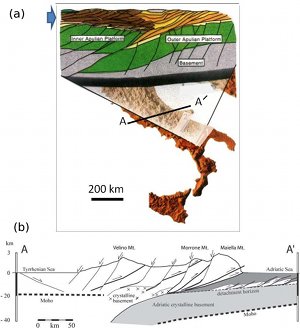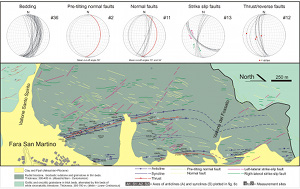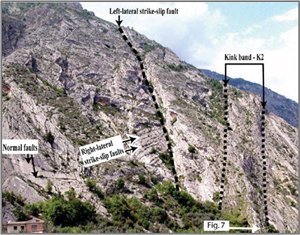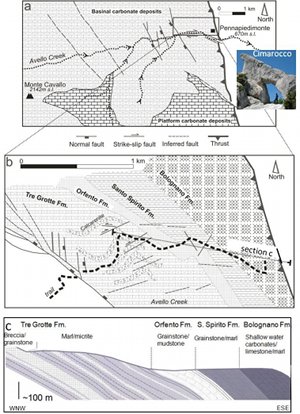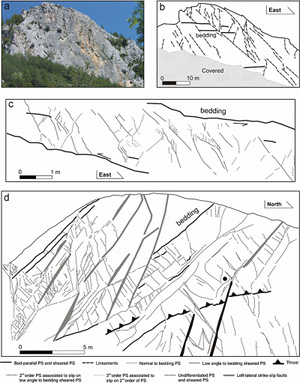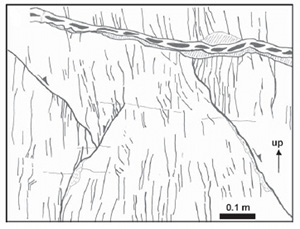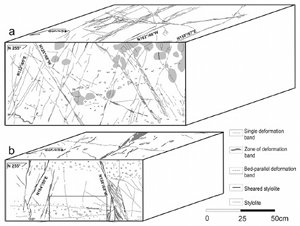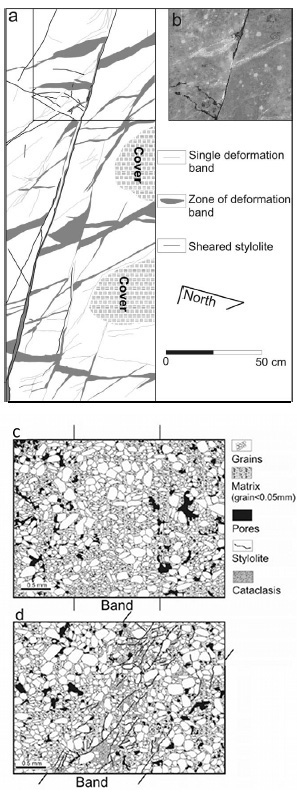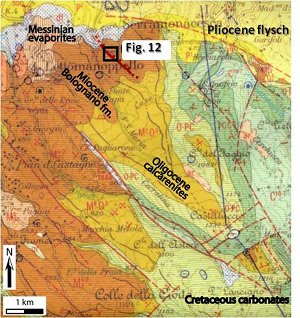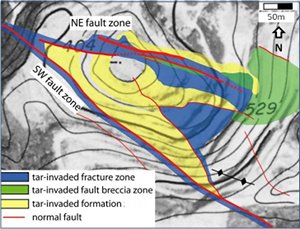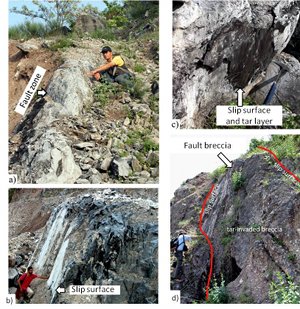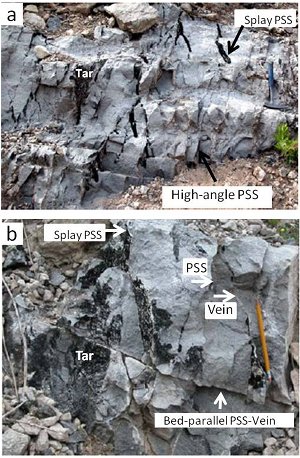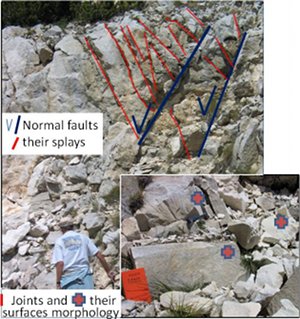| |||||||||
|
|
|||||||||
|
|
|||||||||
| Fractures in Maiella Mountains, Apennines, IT | |||||||||
|
The Oligocene-Pliocene subduction of the Adriatic-Apulian plate below the European margin resulted in tens of kilometers of west to east transport of Mesozoic and Cenozoic rocks over the Apulian Platform and the basement (Figure 1a). The Apennine fold-and-thrust belt is the expression of the deformation produced by this orogeny. The Maiella Mountains, located about 200 km east of Rome in the Abruzzo region, belong to the easternmost of several major thrust sheets within this belt (Figure 1b). Although the Apennines represent one of the most impressive examples for crustal shortening, some enigmatic downfaulting and crustal thinning also accompany the orogeny (see a series of normal faults in the section in Figure 1b). The Maiella structure is a kidney-shaped, major anticlinal dome above an east verging basal thrust fault (Figure 2a). The platform carbonates (Figure 2b), primarily organic limestones, crop out primarily at the south-central part of the structure. On the other hand, slope and basinal micritic limestones and grainstones successions are best seen at the northern edge of the platform along the Avello Creek Valley and along the National Park trail, west of the village of Pennapiedimonte (Figure 2a). The top unit capping the older rocks is a grainstone cropping out primarily along the periphery of the structure and within several quarries. The flysch deposits which help to constrain the age of the basal thrust and down-faulting on the hinterland side, also crop out at the edges of the structure (Figure 2 a, c). Because of the close relationships between the sedimentary architecture-carbonate rock types and the nature and distribution of the deformational structures, we organize this case study report in four parts: 1. The first part deals with the structures within the Cretaceous platform carbonates immediately above the basal thrust, west of the village of Fara San Martino. 2. The second part deals with the deformation of Cretaceous to Miocene slope and basinal carbonates west of the Pennapiedimonte. 3. The third part focuses on the structures specifically within the Miocene grainstones of the Bolognano Formation exposed at two quarries, Madonna della Mazza Quarry and the Roman Quarry near Lettomanoppello at the northern part of the structure. 4. Finally, along the apex of the anticline, west of the La Maiellatta and between Passeo Lancio and Lettomanopello, there occur clear cases for jointing-veining and some normal faults formed by shearing of these opening fractures. The eastern forelimb of the Maiella anticline above the leading edge of the underlying thrust displays a complex system of fractures, faults, and a series of kink bands in the Cretaceous platform carbonates (Figures 3, 4, 5). The fundamental structures dated back to the pretilting phase of the deformation are three orthogonal sets of pressure solution seams: One set is bed-parallel, generally referred to as stylolites, and the other two sets are bed-perpendicular; one situated in strike direction and the other in dip direction of the strata. It turns out that these three initial structure arrays played a significant role in the initiation and development of the three types of faults, thrust-reverse, normal, and strike-slip, in the area. See 'Faulting by Shearing of Pressure Solution Seams' under 'Faulting based on Shearing of Initial Weaknesses.' The kink bands have steep limbs, indicate top-to-the-east shear parallel to the overall transport direction (Figure 3 and Figure 4), and are brecciated and faulted in some places. Also present is a system of pervasive normal faults, trending sub-parallel to the strike of the mechanical bedding but dipping in opposite directions (synthetic and antithetic). These faults accommodate local extension propelled by flexural slip. Also present are two sets of strike-slip faults; one left-lateral at a high-angle to the Maiella thrust, and the other right-lateral intersecting the first one at an acute angle. The normal and strike-slip faults formed by shearing across bed-parallel, and strike- and dip-parallel pressure solution seams and their associate splays. These structures are distributed evenly along the steeper eastern flank of the dome. The thrust faults are better developed at the cores and steep limbs of the kink folds and are generally associated with wide zones of breccias. Except the youngest hairline cracks, all other fault or fold structures appear to have overlapping periods of activity and account for a complex tri-shear like deformation as the front evolved during the orogeny. The slope and basinal sequences onlap the platform at the deeper level (the horizons defined by the Tre Grotte and basinal part of the Orfento formations) along a steep escarpment (Figure 2b), which appears to be faulted from place to place (Figure 2a). The top part of the Orfento Formation and the younger successions, the Santo Spirito and Bolognano, made up of marls and primarily grainstones cap the basin fill. Tilting of these formations increases eastward before the top of the basin fill, the Bolognano sediments truncated against the frontal thrust (Figure 6c). Away from the frontal thrust, towards the interior of the basin, strike-slip and normal faults are common and can be seen well along the Maiella National Park (Parco Nazionale della Majella) trail west of the Pennapiedimonte (Figures 6a, b). Antonellini et al. (2008) provided a detailed description and characterization of these structures, which show similarities and differences with those in the platform carbonates, west of the Fara San Martino. Similar to the low porosity platform carbonates, the dominant fundamental structures are the three mutually orthogonal pressure solution seams, the shearing of which leads to the initiation and development of all three types of faults as we discussed above for the platform carbonates. The thrust faults are common near the eastern front as documented in Figure 7 but both normal and strike-slip faults occur more frequently towards the interior (Figure 6d). A clear difference between the fractures and faults in the platform carbonates and the basinal carbonates is evident in the widespread occurrence of opening mode fractures and joints in micrite and marl units of the Tre Grotte, Orfento and Santo Spirito formations. For example, Figure 8 shows a map of a road cut on the north side of the trail showing that both pressure solution seams and joints play certain roles in fault and damage zone development. Aside from these fracturing and ensuing faulting processes, the grainstone intervals (with porosity of about 20 percent) of the Orfento and Bolognano formations include strain localization features such as deformation bands (compaction and shear bands) which will be the focus of the rest of this case study below. The Madonna della Mazza Quarry, northwest of Pennapiedimonte and the Roman Quarry to northeast of Lettomanoppello (see Figure 2 and Figure 11, respectively, for locations) provide excellent 3D views of the Bolognano grainstones and the structures therein (Figure 9 and Figure 12, respectively). These locations have been studied in detail by Aydin et al. (2005), Tondi et al. (2006), and Agosta et al. (2009). In both locations, multi-thread evidences for triple deformation mechanisms are abundant. These mechanisms are deformation banding (both shear and compaction types) and pressure solution and brittle fracturing or jointing (Figure 13 and Figure 14). Figure 9 and Figure 10 show a network of shear band faults generally with normal sense of slip and sheared pressure solution seams which can be observed on the walls and base of the Quarry. Figure 12 shows traces of two main fault zones labeled as SW and NE zones. Based on the offset of a depositional downlap contact and fault surface morphology, these faults have oblique normal characters with throws on the order of 10 and 40 meters, respectively. Figure 13 includes a series of photographs showing characteristics of the fault zones such as slip surfaces, fault core, and fault breccia zones and their roles in the presence and distribution of tar bodies, which will be revisited again under 'Porosity and Permeability of Faults.'
Clear evidence for opening fractures (joints and veins) occurs in the cap rocks with both limestone and grainstone lithologies. Figure 15 shows a photograph of highly fractured tertiary limestone on the summit road near the pick of the Maiella Mountains, north of the Tre Gretto Valley. On the photograph, evidence for opening fractures based on their surface morphology, normal faulting based on the observed striation and throw, and the associated splay joints are marked. It is also interesting that a series of veins occur perpendicular to large normal faults on a road cut (Figure 16), east of the town of Lettomanoppello.
In summary, a wide variety of structures leading to faulting and folding of the Mesozoic and Cenozoic carbonates of the Maiella Mountains are summarized. First, The platform carbonates along the leading edge of the Maiella Thrust sheet have undergone pressure solution leading to three mutually orthogonal seams. The shearing of these led to the initiation of three fault types, which grew by linkage of their segments. The platform carbonates were also folded in the form of primarily asymmetric tight kink folds. These folds were cored by thrust faults and their steeper limbs were brecciated by a process similar to trishear. The basinal carbonate lithologies have a greater variety of structure types controlled by the variable lithologies and proximity to the frontal thrust and the faulted escarpment at the boundary between the platform and the basin. Near the basal thrust, a hierarchical occurrence of thrust fault patterns has been observed. Towards the interior, both strike-slip and normal faults are common. In porous grainstone units, shear and compaction bands are common. Marly units deformed by both pressure solution and jointing. While pressure solution and deformation bands are common structure types in the Bolognano grainstones capping the basinal sequences, jointing and sheared joint-based faulting is observed in the apex of the dome probably due to higher bending stresses therein. | |||||||||
| Reference: |
|||||||||
| Agosta, F., Alessandroni, M., Tondi, E., Aydin, A., 2010 Antonellini, M., Tondi, E., Agosta, F., Aydin, A., Cello, G., 2008 Aydin, A., Agosta, F., Antonellini, M., 2005 Aydin, A., Antonellini, M., Tondi, E., Agosta, F., 2010 Eberli, G.P., Bernoulli, D., Sanders, D., Vecsei, A., 1993 Ghisetti, F., Vezzani, L., 2002 Graham Wall, B., Antonellini, M., Aydin, A., 2003 Graham Wall, B., Girbacea, R., Mesonjesi, A., Aydin, A., 2006 Royden, L., Patacca, E., Scandone, P., 1987 Rustichelli, A., Tondi, E., Agosta, F., Cilano, A., Giorgioni, M., 2012 Salvini, F., Billi, A., Wise, D.U., 1999 Scisciani, V., Tavarnelli, F., Calamita, F., 2002 Servizio Geologico Italiano, 1970 Tondi, E., Cello, G., 2003 Tondi, E., Antonellini, M., Aydin, A., Marchegiani, L., Cello, G., 2006 Vezzani, L., Ghisetti, F., 1998 |
|||||||||
|
Readme | About Us | Acknowledgement | How to Cite | Terms of Use | Ⓒ Rock Fracture Knowledgebase |
|||||||||
